8.1.1 What are the results of Enterisol® Ileitis?
8.1.1.1 Side-by-side trials
Germany:
In Germany two farms sub-clinically infected with Lawsonia intracellularis were selected for side-by side trials. Both farms were farrow to finishing farms – farm A with 6,000 sows and farm B with 1,500 sows. In total, 1,650 pigs from two (farm A) and four (farm B) successive weekly-farrowing batches were included.
Piglets were vaccinated at 7 weeks of age in farm A and at 3 weeks of age in farm B.
Vaccinated pigs grew faster and achieved higher end weights than non-vaccinated pigs The results are shown in Table 8.1.1.1 a. The increase in the average daily weight gain (ADWG) in response to vaccination was +35g and +21g for pigs on farm A and farm B, respectively (Table 8.1.1.1 a; Figure 8.1.1.1 a).
The feed intake was higher in vaccinated pigs compared to control pigs (Fig. 8.1.1.1 b). The sub-clinical presentation of Ileitis is obviously associated with sub-optimal growth, reduced feed intake and loss of homogeneity in body weights which has recently been shown by multiple authors (Jacobson et al. 2003, Fourchon/Chouet 2000, Guedes 2004 and Paradis 2005). The results in both farms show that in a situation with sub-clinical Ileitis, the vaccine can be highly efficacious.
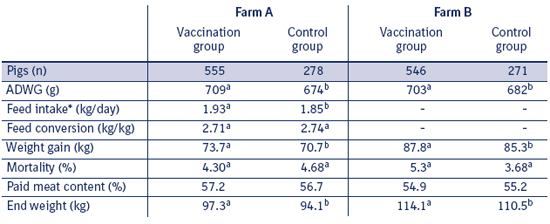
Table 8.1.1.1 a
Least Squares Means for growth performance in the experimental groups on each of the farms during the fattening period.
a,b Means and frequencies in the same row within farm without a superscript in common differ significantly (p ≤ 0.05).
* Feed intake was measured in farm A only
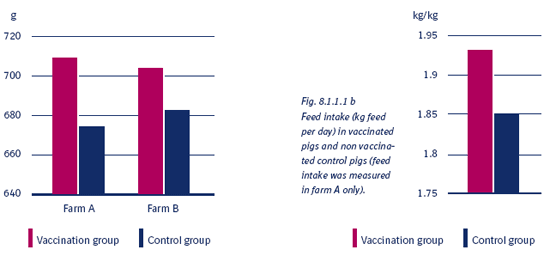
Fig. 8.1.1.1 a
Average daily weight gain in vaccinated pigs and non vaccinated
control pigs in farm A and B.
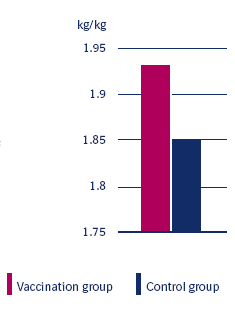
Fig. 8.1.1.1 b
Feed intake (kg feed per day) in vaccinated pigs and non vaccinated
control pigs (feed intake was measured in farmA only).
Switzerland:
In Switzerland a farrow-to-finish farm, operating in a three-week rhythm was suffering from subclinical Ileitis. In a randomised and blinded trial, 279 piglets in four equally sized consecutive groups were vaccinated and compared to 256 non-medicated and non-vaccinated piglets in four similar sized groups of the same age and housed under similar conditions. The farm was free from PRRS, Mycoplasma hyopneumoniae, Brachyspira hyodysenteriae and Brachyspira pilosicoli. Piglets were vaccinated by drench at 3½ weeks of age and weaned at five weeks of age. In the majority of sows and their offspring Lawsonia intracellularis antibodies were present in their blood at the time of vaccination.
The vaccinated animals performed better than the non-vaccinated animals both in the nursery phase and in the fattener phase. The results are summarised in Table 8.1.1.1 b.
This is the first time field results have been collected from a pre-wean vaccination with Enterisol® Ileitis. The results show that Enterisol® Ileitis is efficacious in 3½-week old suckling piglets in the presence of maternal antibodies at the time of vaccination (Voets et al. 2006).

Table 8.1.1.1 b:
Means of production parameters in the Swiss trial.

Picture 8.1.1.1 a (by H. Voets)
Weighing of individual animals at the end of fattening in the Swiss trial.
Greece:
The purpose of the Greek field trial was to investigate the efficacy of Enterisol® Ileitis in a farm suffering from chronic clinical PPE where the inclusion of high levels of zinc oxide in the feed was being applied throughout the whole nursery phase.
In a farrow-to-finish swine farm with 330 sows a randomized block-designed study was carried out with the selection of 161 recently weaned piglets divided into two treatment groups. 2,500 ppm of zinc oxide was being continuously incorporated in the feed of all trial animals during the nursery stage.
ADWG was significantly higher in the vaccinated group (Figure 8.1.1.1 c), while morbidity rate was significantly lower for all vaccinated animals compared to the control group (Figure 8.1.1.1 d).
The concurrent use of 2,500 ppm zinc oxide in the nursery feed – a common practice to reduce the consequences of enteric infections and to enhance the healing properties of the intestine – did not seem to induce any negative effect on the Enterisol® Ileitis efficacy against Lawsonia intracellularis. (Petridou et al. 2006)
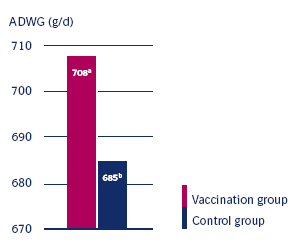
Figure 8.1.1.1c
Average daily weight gain per trial group: Mean in kg.
a,b Values within each parameter with different superscripts, differ significantly (p ≤ 0.05)
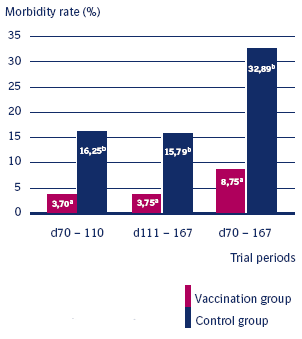
Figure 8.1.1.1d
Morbidity rate (%) of PPE per trial period.
a,bValues within each parameter with different superscripts, differ significantly (p ≤ 0.05)
8.1.1.2 Before – After trials (Statistical Process Control)
In longitudinal trials a SPC (Statistical Process Control) method is performed. The SPC-tool helps to monitor and to identify problem areas in order to optimize a process over an extended period in time. Performance data are mainly compared over a before and after vaccination period, in terms of means, 6-sigma values, and the statistical significance of differences observed and thereafter charted.
Germany:
A study was executed in a German farrow-to-finish farm of 1,600 sows and 10,000 fattening places. All pigs were housed under identical conditions.
Forty-two batches of vaccinated pigs, in total 21,183 animals, are compared to thirty-four batches totalling 17,327 pigs that did not receive a vaccination against Ileitis.
The monitored parameters for the fattening period were average daily weight gain, Feed conversion ratio, mortality, and amount of antibiotic used against enteric diseases.
The ADWG, Feed conversion ratio, mortality and antibiotic use in the vaccinated fattening batches improved significantly. Table 8.1.1.2 a summarizes the results.

Table 8.1.1.2 a Difference in production
performances between vaccinated versus non-vaccinated pigs. * AB use for therapeutic treatment of enteric diseases The SPC charts of this trial show the clear reduction in feed conversion and Antibiotic use. See Figure 8.1.1.2 a and Figure 8.1.1.2 b. They also show a clear reduction of the 6-sigma range. This is the difference between the Upper Control Limit (UCL) and the Lower Control Limit (LCL). A reduction of the 6-sigma range equals a higher level of control over the production process, in this case pig production (Steinheuer et al. 2006). Figure 8.1.1.2 a Figure 8.1.1.2 b 8.1.1.3 Field observations Germany: Case 1: Enterisol® Ileitis was used in a farrow-to-finish farm. Clinical problems due to Lawsonia intracellularis were present in the finishing unit and at the end of the flatdeck, despite the use of up to 200 ppm of Tylosinphosphate (Klatolan feed®) for three weeks or more. Piglets were vaccinated three to four days after weaning. Longitudinal data were captured of four groups of non-vaccinated pigs (n = 785) and compared to four groups of vaccinated pigs (n = 809). The efficacy of the vaccination was very high and the use of antibiotics for the prevention of diarrhoea was ceased completely. Total costs for antibiotics on the farm dropped by 50%. At the same time the groups showed a reduction in variability and the total days of fattening. The farm manager stated that the vaccinated groups had a better overall health status. Problems with respiratory diseases decreased. The ADWG increased on average by 74 g/d and mortality dropped by 2%. Also the percentage of pigs that needed more than 125 fattening days was reduced by 6.1% (see Table 8.1.1.3 a). Case 2: On a farm with 1,550 sows and 12,000 finishing places, 80% of all finishing animals suffered from frequent problems with diarrhoea in 2004. Serology and faecal PCR confirmed the presence of Lawsonia intracellularis and Brachyspira pilosicoli. Salmonellosis, E.Coli and Swine Dysentery were not present. Prophylactic use of CTC + Lincospectin or Tylosin in pulse dose or by injection did not reduce the problems. In December 2004 vaccination with Enterisol® Ileitis was started in piglets of 22 days of age. Table 8.1.1.3 a Table 8.1.1.3 b A decrease in ADWG, despite the use of antibiotics, by 56g/day from 2003 to 2004 due to Ileitis problems is shown in Table 8.1.1.3 b. This decrease was fully recovered to an ADWG of 748g/day in vaccinated animals in 2005. The number of fattening days until slaughter was reduced by 3 days in vaccinated versus medicated animals. The diarrhoea problem disappeared completely after vaccination. The overall conclusion of these two case studies is that Enterisol® Ileitis reduces the clinical problems related to Ileitis significantly. An increase in ADWG is seen in the finishing groups, whereas slaughter weight variability is significantly reduced within and between the groups. The reduction of antibiotic use is something that should be extrapolated carefully to other farms which start to vaccinate with Enterisol® Ileitis, to prevent over-expectation of the vaccine regarding the ability to reduce antibiotics. (Henke et al. 2006). 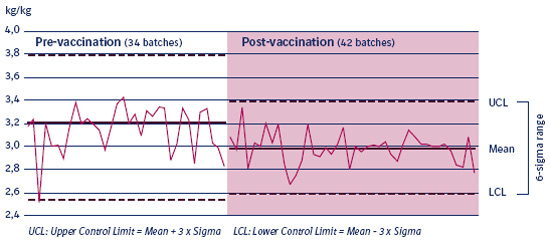
SPC chart of feed conversion ratio in different
batches before and after vaccination.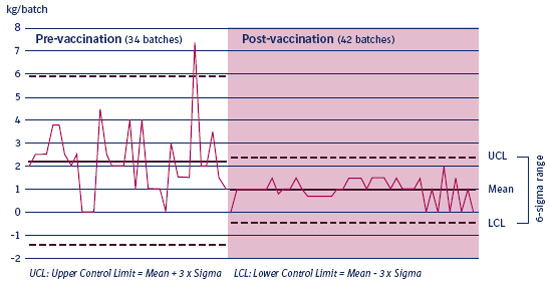
SPC chart of Antibiotic use per batch.
Results after vaccination with Enterisol® Ileitis.
Results of different strategies against Ileitis.
© Boehringer Ingelheim Animal Health GmbH, 2006
All rights reserved. No part of this Technical Manual 3.0 may be reproduced or transmitted in any form or by any means, electronic or photocopy, without permission in writing from Boehringer Ingelheim Animal Health GmbH.




